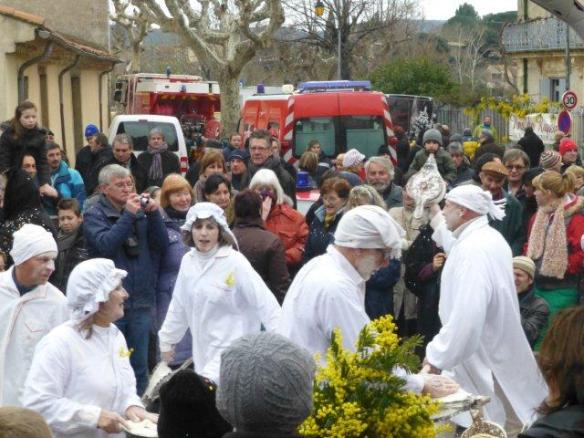Many years ago, I went to a restaurant in a little hamlet called Fauzan, high up in the garrigue above the village of Cesseras. On my first visit there, I joined friends to celebrate a significant birthday – we all had a wonderful time there! The restaurant was known by the family name of the brother and sister who owned and ran it: Restaurant Chabbert. Mme Chabbert was in the kitchen, preparing rustic and hearty fare. Her brother looked after the vineyards and the wine cellar, and was often working at the restaurant too. I went to the restaurant several times when the Chabberts were running it. Here are a few pictures from some of those visits:
One day, Mr and Mme Chabbert retired and the restaurant closed its doors, to the chagrin of many people. For two and a half years the restaurant lay empty, its doors locked, the kitchen shut, the car park abandoned.
Until…. Christophe and Audrey Cabrol managed to persuade the Chabbert siblings to allow them to rent the premises. Christophe has been passionate about food and cooking from an early age, and has been cooking professionally for over 20 years Audrey, Christophe’s wife, looks after the dining room, after having been an events manager for many years. The restaurant is now called La Bastide de Fauzan.
The appearance of the dining room has changed only a little, but the food has changed a lot!! My camera has also improved over the years 🙂
I’ve been to La Bastide de Fauzan twice in the last three months – both times with friends – and each time there was a lovely fire crackling away in the fireplace.
 We had drinks and nibbles by the fire, whilst catching up!
We had drinks and nibbles by the fire, whilst catching up!
 On both visits, everyone had the menu at 34 Euros. There are two other menus, one at 25 Euros and another at 55 Euros. All three menus can be found on the restaurant’s website
On both visits, everyone had the menu at 34 Euros. There are two other menus, one at 25 Euros and another at 55 Euros. All three menus can be found on the restaurant’s website
Our mise en bouche or mini appetizer was a delicious combination of smoked salmon and cream cheese!
On our menu, we had two different starters to chose from: scrambled eggs with wild mushrooms …
… or flambeed gambas on buttered cabbage with cauliflower veloute.
 I had eaten the gambas on my first visit, and absolutely delicious they were too(!), so I chose the scrambled eggs on my second visit – they were wonderfully creamy, and the taste of the mushrooms was great!
I had eaten the gambas on my first visit, and absolutely delicious they were too(!), so I chose the scrambled eggs on my second visit – they were wonderfully creamy, and the taste of the mushrooms was great!
After the starter came the terrine! This is very much like a pate de campagne – it is made with pork and various seasonings and it was very tasty! The terrine is a house speciality which has a long and time-honoured tradition, dating back to when Mme Chabbert was in charge of the kitchen!! Everyone just cut as much or as little as they liked!!
 I was starting to feel pleasantly full after the terrine, but there was more to come, in the shape of the main course!!
I was starting to feel pleasantly full after the terrine, but there was more to come, in the shape of the main course!!
Seabass filet with tapenade:
Slowly braised veal:
 On my first visit, there had also been wild boar stew:
On my first visit, there had also been wild boar stew:
All of the main courses were utterly delicious!! AND there were two more courses yet to come!
First was the cheese course, where there was a choice of either curd cheese with honey:
… or an assortment of cheeses:
The cheese course was followed by dessert. Once again, there were several choices!
A melting chocolate cake served with mandarin sorbet:
 A mandarin orange and chestnut tart:
A mandarin orange and chestnut tart:
 Poached pear with vanilla ice cream, served on a bed of almond crumble:
Poached pear with vanilla ice cream, served on a bed of almond crumble: It was tough to chose which dessert to order – they were all so delicious!!
It was tough to chose which dessert to order – they were all so delicious!!
We rounded off our meal with a lemon verbena infusion – Audrey picked the lemon verbena fresh from the garden just for us!
On both occasions we had great meals and the experiences were wonderfully relaxing and unhurried, friendly and delicious. We all felt very happy when we left! 🙂
I am looking forward to going back for another meal as soon as the weather is warmer and we’ll be able to eat on the terrace which overlooks a lovely garden!
If you want to visit La Bastide de Fauzan please be sure to book, either by e-mail (contact@bastidefauzan.fr) or by phone (+33 4 68 75 43 46). You can find the current menu here.


































































































